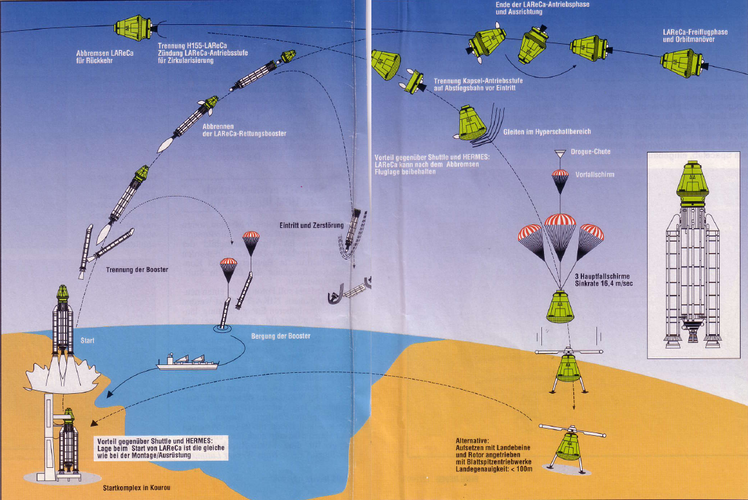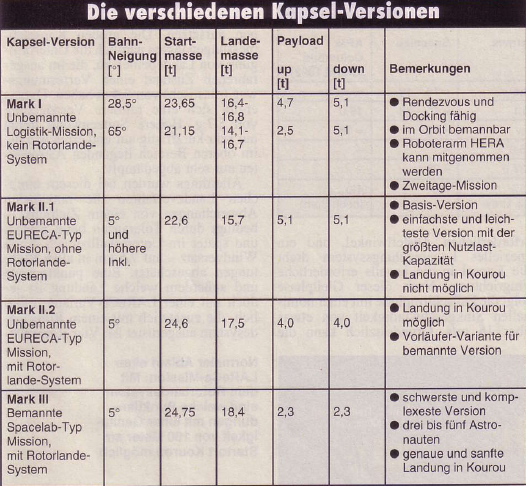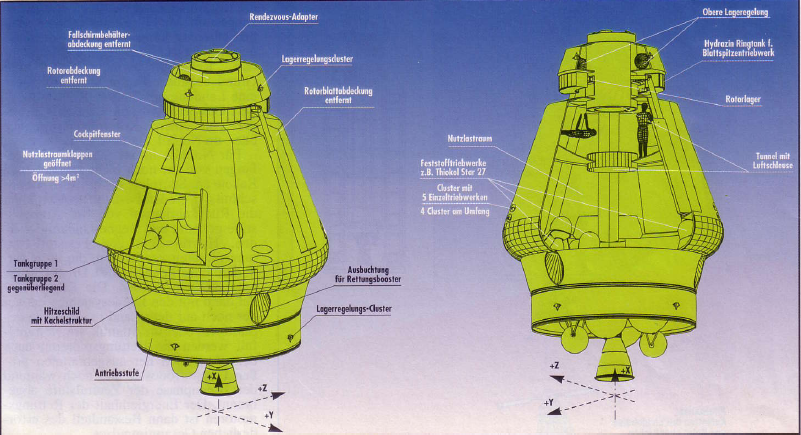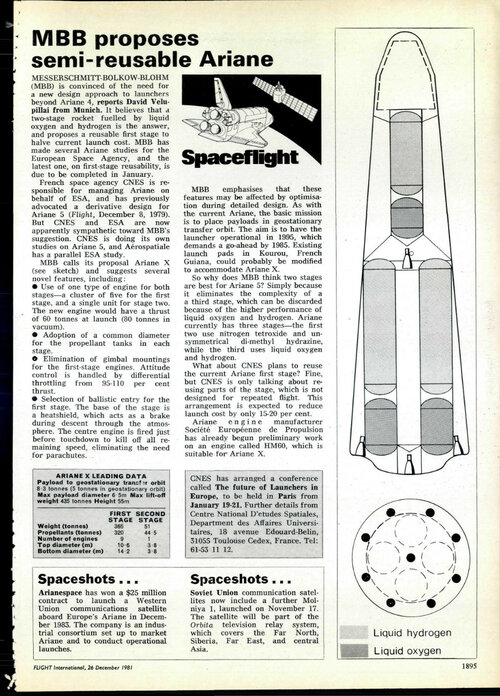So I was thinking of a combination of the hermes and hotol concepts, with the uk making the engine using lace (into saber) and the French doing the fuselage, but I'm not really sure what the other esa members would do. Germany for example really needs to do something to make this a Esa wide project, but other then a first stage (in wich case why bother with the lace engine) and electronics seems like that should go to the smaller countries (like Italy), the only idea i had was splitting fuselage development, but that seems like a tarabole idea.
You are using an out of date browser. It may not display this or other websites correctly.
You should upgrade or use an alternative browser.
You should upgrade or use an alternative browser.
1980's European space plane
- Thread starter Cjc
- Start date
Alas, HOTOL design did not "closed" as they say. Would not work, well that's why they went with Skylon and Sabre.
(@steelpillow would tell you it it can't work either because the SABRE on the wingtips would ruin the rear fuselage).
Hermes could have worked but ended morbidly obese at 25 tons, turning Ariane 5 into a bloated monster.
Now an Apollo like capsule, that something CNES and ESA could I have done.
(@steelpillow would tell you it it can't work either because the SABRE on the wingtips would ruin the rear fuselage).
Hermes could have worked but ended morbidly obese at 25 tons, turning Ariane 5 into a bloated monster.
Now an Apollo like capsule, that something CNES and ESA could I have done.
- Joined
- 25 June 2014
- Messages
- 1,564
- Reaction score
- 1,483
R-R pulled out because Alan Bond's big idea was way ahead of its time and the technology needed a long programme of development with no guarantee they could make it work. So the orbiter would have been powered by conventional rockets, as Hermes/Shuttle/Buran. And as @Archibald reminds us, the engines need to be well aft and well inboard.
The main question would then have been - vertical or horizontal launch? BAe had MUSTARD in their back pocket, so the politicians would have fought out a MUSTARD-cluster vs. Hermes-stack battle for the sake of the bragging rights, with Gorbachev's new, curtain-free Russia stepping in as a late outsider with a Mriya + horizontal mini-Buran "neither loses to the other by choosing this instead" classic gambit.
The cost vs capacity tradeoff would have also caused a battle between a manned option at unaffordable cost and an unmanned (or potentially one-manned) option of questionable usefulness. Mriya + mini-Buran would have probably needed a second-stage booster strapped to the spaceplane, but it would have split an intermediate budget across an extra payer, so might have proved politically feasible.
Was it technically feasible? Nominally, yes. But the bitter status struggles and Camel decisions that always dog international collaboration would have left it struggling to achieve orbit with a payload bigger than a postcard. The first iteration would have been a sub-orbital, unmanned spaceplane. Two semi-independent developments would have sent up a payload-incapable orbiter and a manned sub-orbital joyride.
By now the technology was obsolescent and the operational capability demonstrably next to useless. Russia was hardening off again under a resurgent right wing, costs were escalating and the will to collaborate on a refresh was fading fast. Capability was kept up to save face while the Shuttle still rode, but a planned Mriya II with ISS-rendezvous capable orbiter was cancelled.
History closed around itself and the world returned to the timeline it was always going to follow.
The main question would then have been - vertical or horizontal launch? BAe had MUSTARD in their back pocket, so the politicians would have fought out a MUSTARD-cluster vs. Hermes-stack battle for the sake of the bragging rights, with Gorbachev's new, curtain-free Russia stepping in as a late outsider with a Mriya + horizontal mini-Buran "neither loses to the other by choosing this instead" classic gambit.
The cost vs capacity tradeoff would have also caused a battle between a manned option at unaffordable cost and an unmanned (or potentially one-manned) option of questionable usefulness. Mriya + mini-Buran would have probably needed a second-stage booster strapped to the spaceplane, but it would have split an intermediate budget across an extra payer, so might have proved politically feasible.
Was it technically feasible? Nominally, yes. But the bitter status struggles and Camel decisions that always dog international collaboration would have left it struggling to achieve orbit with a payload bigger than a postcard. The first iteration would have been a sub-orbital, unmanned spaceplane. Two semi-independent developments would have sent up a payload-incapable orbiter and a manned sub-orbital joyride.
By now the technology was obsolescent and the operational capability demonstrably next to useless. Russia was hardening off again under a resurgent right wing, costs were escalating and the will to collaborate on a refresh was fading fast. Capability was kept up to save face while the Shuttle still rode, but a planned Mriya II with ISS-rendezvous capable orbiter was cancelled.
History closed around itself and the world returned to the timeline it was always going to follow.
R-R pulled out because Alan Bond's big idea was way ahead of its time and the technology needed a long programme of development with no guarantee they could make it work. So the orbiter would have been powered by conventional rockets, as Hermes/Shuttle/Buran. And as @Archibald reminds us, the engines need to be well aft and well inboard.
The main question would then have been - vertical or horizontal launch? BAe had MUSTARD in their back pocket, so the politicians would have fought out a MUSTARD-cluster vs. Hermes-stack battle for the sake of the bragging rights, with Gorbachev's new, curtain-free Russia stepping in as a late outsider with a Mriya + horizontal mini-Buran "neither loses to the other by choosing this instead" classic gambit.
The cost vs capacity tradeoff would have also caused a battle between a manned option at unaffordable cost and an unmanned (or potentially one-manned) option of questionable usefulness. Mriya + mini-Buran would have probably needed a second-stage booster strapped to the spaceplane, but it would have split an intermediate budget across an extra payer, so might have proved politically feasible.
Was it technically feasible? Nominally, yes. But the bitter status struggles and Camel decisions that always dog international collaboration would have left it struggling to achieve orbit with a payload bigger than a postcard. The first iteration would have been a sub-orbital, unmanned spaceplane. Two semi-independent developments would have sent up a payload-incapable orbiter and a manned sub-orbital joyride.
By now the technology was obsolescent and the operational capability demonstrably next to useless. Russia was hardening off again under a resurgent right wing, costs were escalating and the will to collaborate on a refresh was fading fast. Capability was kept up to save face while the Shuttle still rode, but a planned Mriya II with ISS-rendezvous capable orbiter was cancelled.
History closed around itself and the world returned to the timeline it was always going to follow.
None of the 1992 era concepts made a lot of technical sense. Even as a 10 year old I already smelled something was amiss. I started to dip my toe and whack my brain into RLV concepts. Even if the lack of Internet did not helped.
Orion Express and HOTOL and Saenger were pipe dreams, Hermes was obese DynaSoar.
HOTOL 2 on An-225, the prop mass fraction would still be a major PITA even with some help from the huge airplane below.
MAKS was pretty smart: at least the RD-701 triprop engines - but then why such an enormous drop tank ? I thought triprop (plus An-225 little boost) were to close the SSTO gap.
TheRejectionist
ACCESS: Secret
- Joined
- 2 February 2022
- Messages
- 232
- Reaction score
- 62
So, like a Bond movie airplane?
- Joined
- 13 August 2007
- Messages
- 7,881
- Reaction score
- 9,010
Capsule vs. Glider
There were dispute and conflict for capsule or Glider in CNES or ELDO and ESA
In end won the Glider for simple reason the Europeans had no equipment to recover the Capsule & Crew from Sea
what result in higher mission cost compare to glider that use runway
The Lareca capsule circumvent that problem by landing on land, but its rotor landing system not look so trustworthy...
There were also Lifting body study
On Hermes
it mostly French fault and Germany finish the job with axe...
Original Hermes was small Spaceplane launch with conventional Ariane (3-4) rocket
but CNES change the design constantly, getting bigger and heavier
Like putting Cargobay in it, transforming Hermes into French Space Shuttle !
Then happen Challenger disaster in 1986
The Original "we goes for a launcher with 99,999% success rate" change "we need Crew Escape system"
and Hermes got heavier and too expensive for France and ESA and need bigger rocket Ariane 5
1991 came German Unification and Germany needed the money elsewhere and swing the budget Axe on Spaceflight...
Had CNES not be so ambitious and focus on prime objective to bring People and Experiments into Orbit.
Hermes could have flew as Dyna Soar like spaceplane in 1990s
There were dispute and conflict for capsule or Glider in CNES or ELDO and ESA
In end won the Glider for simple reason the Europeans had no equipment to recover the Capsule & Crew from Sea
what result in higher mission cost compare to glider that use runway
The Lareca capsule circumvent that problem by landing on land, but its rotor landing system not look so trustworthy...
There were also Lifting body study
On Hermes
it mostly French fault and Germany finish the job with axe...
Original Hermes was small Spaceplane launch with conventional Ariane (3-4) rocket
but CNES change the design constantly, getting bigger and heavier
Like putting Cargobay in it, transforming Hermes into French Space Shuttle !
Then happen Challenger disaster in 1986
The Original "we goes for a launcher with 99,999% success rate" change "we need Crew Escape system"
and Hermes got heavier and too expensive for France and ESA and need bigger rocket Ariane 5
1991 came German Unification and Germany needed the money elsewhere and swing the budget Axe on Spaceflight...
Had CNES not be so ambitious and focus on prime objective to bring People and Experiments into Orbit.
Hermes could have flew as Dyna Soar like spaceplane in 1990s
Ariane 44L max payload to orbit was 7 mt. Was Hermes launcher back in '79
The derivate Ariane 5R (Reference) with a ninth Viking on stage 1 and HM-60 Vulcain (hydrolox) on stage 2: 15 mt.
Final Ariane 5P, (ATV heaviest flight to LEO): 23 mt.
But Hermes ended at 25 mt !
As of 1986 Ariane 5 had P170 solid fuel booster: poudre, 170 tons each.
By 1992 they had grown to P240 !
The derivate Ariane 5R (Reference) with a ninth Viking on stage 1 and HM-60 Vulcain (hydrolox) on stage 2: 15 mt.
Final Ariane 5P, (ATV heaviest flight to LEO): 23 mt.
But Hermes ended at 25 mt !
As of 1986 Ariane 5 had P170 solid fuel booster: poudre, 170 tons each.
By 1992 they had grown to P240 !
martinbayer
ACCESS: Top Secret
- Joined
- 6 January 2009
- Messages
- 2,904
- Reaction score
- 3,005
Even Chinese copycats can do crewed capsules by now. The real drivers for spaceflight these days should be relevant missions and applications, not architectures for the sake of themselves. We should be well past the climbing Mount Everest just because it's there point. Flags and footsteps was fun while it lasted, but being the fourth in putting people in orbital cans is hardly moving the needle anymore.Alas, HOTOL design did not "closed" as they say. Would not work, well that's why they went with Skylon and Sabre.
(@steelpillow would tell you it it can't work either because the SABRE on the wingtips would ruin the rear fuselage).
Hermes could have worked but ended morbidly obese at 25 tons, turning Ariane 5 into a bloated monster.
Now an Apollo like capsule, that something CNES and ESA could I have done.
Last edited:
Having the orbiter free and clear piggyback style does allow for a wider wingspan---and a modular LV that could be used for other things perhapsSo the orbiter would have been powered by conventional rockets, as Hermes/Shuttle/Buran. And as Archibald reminds us, the engines need to be well aft and well inboard.
View: https://imgur.com/Ggva9D9

STCAEM-CAB: A Mouthful of a Mars Mission (Space Exploration Initiative, Part II)
What it was: One of the products of 1991 study by Boeing for a Mars mission vehicle. Technologically it was the most conservative of the possible craft they suggested, relying entirely on cryogenic…
SpaceLiner is their baby:. Germany for example really needs to do something to make this a Esa wide project,

SpaceLiner - Wikipedia
The polar opposite of HOTOL. Shove the airbreather--learn to love the pure rocket.
maybe not fourth······India's plan will be delayed, but not cancelledEven Chinese copycats can do crewed capsules by now. The real drivers for spaceflight these days should be relevant missions and applications, not architectures for the sake of themselves. We should be well past the climbing Mount Everest just because it's there point. Flags and footsteps was fun while it lasted, but being the fourth in putting people in orbital cans is hardly moving the needle anymore.Alas, HOTOL design did not "closed" as they say. Would not work, well that's why they went with Skylon and Sabre.
(@steelpillow would tell you it it can't work either because the SABRE on the wingtips would ruin the rear fuselage).
Hermes could have worked but ended morbidly obese at 25 tons, turning Ariane 5 into a bloated monster.
Now an Apollo like capsule, that something CNES and ESA could I have done.
Similar threads
-
-
-
Applications of a successful F401
- Started by Yellow Palace
- Replies: 17
-
UK and European alternatives to Typhon and AEGIS
- Started by uk 75
- Replies: 21
-




